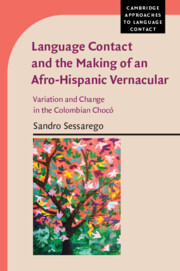 Language Contact and the Making of an Afro-Hispanic Vernacular
Language Contact and the Making of an Afro-Hispanic Vernacular Published online by Cambridge University Press: 23 August 2019
Slavery existed since antiquity and assumed, depending on the times and places, different forms and legitimations (Winks 1972). As far as black slavery in the colonial transatlantic context is concerned, different scholars have suggested divergent hypotheses on the nature of the Spanish system in relation to the systems implemented by the other European powers that took part in the colonization of the Americas. In particular, while certain researchers, such as Tannenbaum (1947), have claimed that Spanish slavery was less harsh in the treatment of slaves than the other systems (see also Freyre 1940), other authors, such as Boxer (1962), Davis (1966), and Genovese (1967), have objected that even though the Spanish written regulations might have appeared more humane and less strict, the actual praxis of slavery across Spanish colonies would contradict such an idealized vision, so that the life of a slave living in a Spanish colony would have essentially been like the life of a slave working across the territories belonging to other European colonial powers, especially if such a captive was living in plantations or mines far away from the urban centers, where it was materially impossible to resort to the law to protect one’s legal rights.
To save this book to your Kindle, first ensure [email protected] is added to your Approved Personal Document E-mail List under your Personal Document Settings on the Manage Your Content and Devices page of your Amazon account. Then enter the ‘name’ part of your Kindle email address below. Find out more about saving to your Kindle.
Note you can select to save to either the @free.kindle.com or @kindle.com variations. ‘@free.kindle.com’ emails are free but can only be saved to your device when it is connected to wi-fi. ‘@kindle.com’ emails can be delivered even when you are not connected to wi-fi, but note that service fees apply.
Find out more about the Kindle Personal Document Service.
To save content items to your account, please confirm that you agree to abide by our usage policies. If this is the first time you use this feature, you will be asked to authorise Cambridge Core to connect with your account. Find out more about saving content to Dropbox.
To save content items to your account, please confirm that you agree to abide by our usage policies. If this is the first time you use this feature, you will be asked to authorise Cambridge Core to connect with your account. Find out more about saving content to Google Drive.